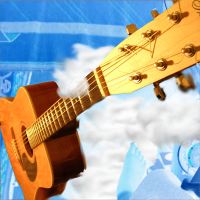Q What is the AYoS recording rig like?
A In a word... cheap. Mostly.
I leave my favorite vocal/guitar mic, a Rode NT1, set up on its stand (with a mic sock over it -- a plastic baggy held tightly closed by a clothespin to protect it from dust) so it's handy when I want to record.
I know pretty much what I want, so my board, a Mackie SR-24 VLZ, stays set up as do the settings on my low-end tube limiter (a "vintage" ART Dual Levelar) which I use between the board's direct out and my computer audio interface, a MOTU 828mkII Firewire box that has 10 analog ins and 12 analog outs, as well as ADAT i/o. I also have an Echo Mia PCI interface inside the computer tower, as well as a SoundBlaster clone built into the motherboard.
Since I used to have a small project studio, I have a number of low end preamps, tube and solidstate, but I've found I prefer the mic pres on the Mackie, as a rule. I bought the board when I was still running a couple ADAT digital tape machines and mixed out of the box folding in the outputs of an elaborate MIDI rig live into the realtime mix.
But these days, I tend to use virtual synths and keyboards of various kinds (my faves are Mr Ray 73, a modeled Rhodes, and ZR-3 and ORGANizedTrio, both B3 modellings) and mix in the box.
My keyboard controller is a CME UF8, fully hammer-weighted 88 key piano style controller. It's not everyone's cup of tea, having a heavy, quasi-real piano style action that makes lighting fast synth runs a lot harder. But I left that behind in my Frippenstein/Tranz Azul days. Now, I find the heavy piano feel particularly familiar and welcome, since my 115 year old real piano is sidelined in the garage below me.
I almost always use Sonar as my DAW (digital audio workstation to those of you hanging on to this sidebar by your fingernails) -- specifically Sonar Producer 6, which I like pretty well.
Though I began using synthesizers in 1981, learning on an expanded Moog Model 15, which was patched with real patch cords and programmed (sequenced) using control voltages, my immersion in MIDI was rather late, in 1991 and 1992when I began using my Kawai K4 multitimbral sample-based synth with my PC, using the old MasterTracks Pro software.
MTPro didn't make the transition to digital audio but the previously rather clunky Cakewalk did, turning kind of glamorous overnight, when they were first software to take advantage of Windows 95's OS level multichannel audio layer. I'd been running a pair of ADAT 8 track digital audio recorders and I immediately put them to use as the i/o interfaces for an 8 channel DAW.
That was Cakewalk Pro Audio 6 in 1996, coming out with yearly updates that added more and more features incrementally. In 2001, they changed the name to Sonar and started the version count over, so I'm using Sonar 6, which came out last fall. The Producer edition costs an extra hundred bucks or so for each update but includes a grab bag of usually valuable tools that would be far more expensive in their full versions.
I also have Mackie's Tracktion and the amazing shareware multitracker, Reaper. I've used Tracktion a few times -- but I have Sonar set up just as I want it, using templates to make it a more or less turnkey operation. I select the AYoS template and everything is set up and ready to hit the record button.
When I'm ready to mix (which is usually pretty simple because there are seldom more than one or two overdubs, and often, just a single track with no 'dubs), my favorite bus EQ and compressor (Timeworks CompressorX and EQ, both of which came with Sonar 2 Producer) are already in place, ready to engage, my favorite settings already set up on them.
The recordings are almost always done with the single Rode NT1 mic. At first I was setting up the Rode for my vocals and setting up my favorite relatively flat mic, an Equitek II on the guitar in the center of the room, away from reflecting walls, using a wireless remote to control the recording softare. And I was getting a pretty nice sound.
But, let's face it, recording and uploading a song a day (as I did nearly the first 8 months of AYoS) and creating a web page for it, even with the help of blog software, was a pain. Something had to give. Setting up a single mic right by my computer was a compromise -- but the tradeoff in sound quality was, actually, surprisingly small.
Regular AYoS visitors will no doubt be unsurprised when I say that little in the way of editing or mixing goes into the typical AYoS project but, when I need to, I can get in and move the errant note around (at least with lead guitar accompaniment) or take out an offending verse or a chorus that's been repeated one too many times.

